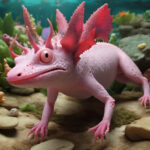Students 3D-print ‘hybrid drone’ that flies, swims, and resurfaces in seconds
A team of applied industrial electronics students at Aalborg University in Denmark has built and successfully tested a groundbreaking ‘hybrid drone’ that showcases the power of innovation and technology convergence. This remarkable creation can seamlessly transition between flying in the air, swimming underwater, and resurfacing within a matter of seconds, opening up a myriad of possibilities for various industries and applications.
The students leveraged their expertise in 3D printing and industrial electronics to design and construct this versatile hybrid drone. By combining elements of aerial drones and underwater drones, they have pushed the boundaries of conventional drone capabilities and introduced a new paradigm in unmanned aerial vehicles (UAVs).
One of the key highlights of this hybrid drone is its ability to smoothly transition between different modes of operation. Equipped with specialized propellers and waterproof casings, the drone can take off from land, soar through the skies like a traditional drone, dive into the water, maneuver beneath the surface with precision, and resurface effortlessly. This seamless functionality is a testament to the students’ ingenuity and technical prowess.
The implications of this hybrid drone are far-reaching and impactful. In the realm of environmental monitoring, the drone can be deployed to gather data above and below the water’s surface, offering researchers and scientists a comprehensive view of aquatic ecosystems. Similarly, in search and rescue missions, the drone’s dual functionality enables it to swiftly navigate diverse terrains and provide assistance in critical situations.
Furthermore, industries such as maritime exploration, infrastructure inspection, and marine conservation stand to benefit significantly from the capabilities of this hybrid drone. Its versatility and agility make it an invaluable asset for tasks that require both aerial and underwater assessments, revolutionizing how data is collected and analyzed in various sectors.
The successful development of the hybrid drone underscores the importance of interdisciplinary collaboration and innovative thinking in today’s rapidly evolving technological landscape. By bridging the gap between different fields of study and exploring novel applications of existing technologies, the students at Aalborg University have demonstrated the boundless potential of integrating diverse skill sets and knowledge domains.
As we look to the future, the emergence of hybrid drones like this one paves the way for a new era of multifunctional UAVs that can adapt to dynamic environments and perform a wide range of tasks with precision and efficiency. The fusion of aerial and aquatic capabilities in a single compact device represents a significant leap forward in drone technology and sets the stage for further advancements in the field.
In conclusion, the ‘hybrid drone’ developed by the students at Aalborg University exemplifies the spirit of innovation, collaboration, and forward thinking that drives progress in the realm of unmanned aerial vehicles. With its ability to seamlessly navigate the skies and the seas, this groundbreaking creation heralds a new chapter in the evolution of drones and inspires us to rethink the possibilities of aerial and aquatic exploration.
innovation, technology, drone, Aalborg University, hybrid drone












